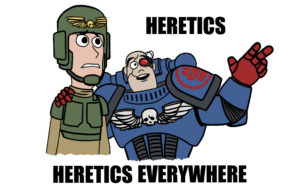 The Wicked and the Damned
The Wicked and the Damned
Warhammer Horror
Black Library
April 2nd 2019
Paperback, eBook

Three outstanding authors stretch their wings in the first outing in the Warhammer Horror line.
If you’ve read any number of Warhammer 40,000 novels, you know that they are, by nature, horrific. In the grim, dark future there is only war and the laughing of thirsting gods, which is not the friendliest of settings. I was curious how Black Library was going to make their horror line stand out. The Wicked and The Damned has made me a believer and a fan. Not only does the book work within the confines of the universe, it is undeniably scary from start to finish.
Flax Golden Tales to Spin
The smartest thing The Wicked and The Damned does lays in its premise: three survivors have gathered on a funerary planet for unknown reasons. As they attempt to figure out their purpose, they each tell their tale of what brought them to their location. Each story is told first-person, as a memoir, and is penned by a different author.
This masterstroke lends to the authenticity of the voices of each of the characters. They all share a commonality, but their tales are so varied that had one author been writing each story, something would have been lost in the translation. Reading each story invokes each of the authors’ styles, and adds to the campfire tale feeling, which is just delightful.
The characters come from a different walk of life (we meet a commissar, a guardswoman, and a priest), and encounters a different horror of the 41st millennium. Furthermore, each character shares an innate belief that theirs are different from the others. As each person’s tale unfolds, none of them are able to relate the tale to their own experience. It adds that human element that so many horror novels and movies often overlook.

Monsters Lurking Amongst Daemons
When reading books about daemon princes, plague gods, and murderous fungi, it’s easy to lose some of the horror because of the vast, large scale of said foes. In Dark Imperium, for example, horrific plague-bringers are taking over a planet, but because of the planetary scale, it feels less intimate. The Wicked and The Damned’s focus on individual characters brings the horror closer to home and creates a claustrophobic feel; there’s no escaping the monsters that haunt these pages.
In “The Beast in the Trenches,” the evils of the human heart prowl amongst the trenches of an awful war, providing the worst (as in, this sounds like a terrible experience) glimpse into the machinations of the Imperium. The life of a guardsman is not glamorous and more often than not short and terrifying. This story was my personal favorite of the group. It hit key elements that I love in a horror novel, mostly an escalating, inescapable evil, and a narrator who isn’t “reliable.”
In “The Woman in the Walls,” we’re presented with a Japanese-style horror story that features a terrifying specter lurking in the shadows of a ship in warp travel. Traveling in WH40k always sounds scary as is (especially as characters dismiss the main character’s fears as “typical warp stuff”), but adding a malevolent hunter makes it somehow worse. This story legit gave me nightmares, because it conjured long-harbored memories of Fatal Frame II.
“The Faith and the Flesh” is a good old-fashioned monster story and while a tad predictable, there is a macabre wonder invoked within. The story reminds us what an awesome sight an Adeptus Astartes is to the common man, and that Roboute Guilliman isn’t the only Imperial citizen with a crisis of faith.
When the Music Stops…
When The Wicked and The Damned was over, I was genuinely sad. Not only did I read the book in one weekend (almost one day, but I ran out of gas), I wanted more. Even though I had pieced together endings and themes, the book still kept me on edge throughout. It’s a wonderful foray into the genre, and I would read a horror novel by any of these authors any time.